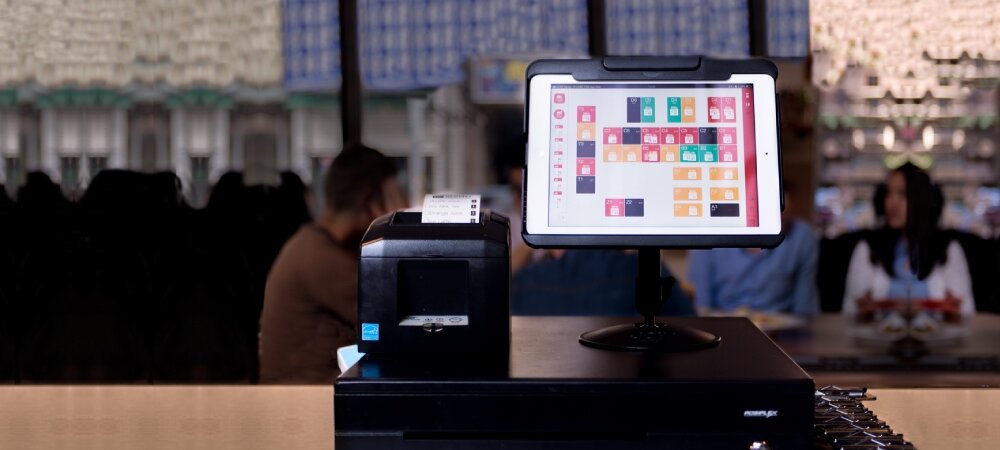If you’ve been to IMDA’s website looking for grants for your F&B business, you might be scratching your head trying to understand the difference between Digital Ordering, Online Ordering, and Online Food Delivery. These are terms categorizing IT solutions for F&B outlets, under the Productivity Solutions Grant (PSG), which allows you to claim 80% of the cost.
Although they sound similar, they actually serve different purposes and it’s important to know which is needed for your business.
1. Digital/ Online Ordering
Based on the descriptions and a survey of pre-approved solutions under the “Digital Ordering/Online Ordering and Payment” category of IMDA’s Productivity Solutions Grant (PSG), “Digital/Online Ordering” refers to newer ordering systems, or POS (point of sale) systems, that are cloud-based and use tablets to place orders.
While POS systems have been an essential part of F&B businesses for a long time, many of those on the market are traditional or legacy POS systems – essentially computers with POS software installed on them. They perform basic functions such as order recording, billing, and sometimes inventory management.
Digital/ Online Ordering POS systems are more technologically advanced and dynamic, allowing for regular updates to their software, remote management, integration with other software such as accounting, and more. They are meant for F&B businesses’ internal use and reduce the number of tasks done manually, increasing productivity at your restaurant. Some systems might allow customers to order with their mobile phones, by scanning a QR code or visiting a website URL. Once confirmed, the order is sent to the POS system. This is usually in addition to the standard tablet ordering mentioned above.
The Singapore government has encouraged F&B businesses to adopt Digital/ Online Ordering POS systems since 2018 by offering up to 70% subsidy (now 80% until 31 Dec 2020) on such solutions. Vendors providing Digital Ordering/ Online Ordering solutions with this subsidy have to undergo a strict qualification process to be pre-approved under the PSG.
iCHEF POS system is an example of a PSG pre-approved Digital/Online Ordering POS system. It is able to perform tasks such as ordering, billing, inventory, tracking of sales, and employee management.
Pros and Cons of Digital/Online Ordering
Pros:
Lightweight – Typically smaller and sleeker than traditional POS systems
Accessible anywhere – Being cloud-based, you can easily view your sales and other reports on any device that is connected to the Internet.
Flexible – You can make changes to your menu, edit prices, and manage promotions on your own without any help from tech support.
Safe – Because your data is backed up on the cloud, you don’t have to worry about hardware breakdown. It can be easily retrieved when you log in on a new device, unlike traditional POS systems where your data is lost if your hardware is damaged.
Cons:
Requires Internet connectivity – Some systems might not function if the WIFI connection is interrupted. Check with your POS provider if their system has an offline mode or if the system can continue to operate without an Internet connection.
Hardware cost – Most Digital Ordering systems use Apple iPads, which are more expensive than traditional POS hardware. This is because iPads are more reliable and there are dedicated Apple tech support and repair. However, with the PSG, Digital Ordering solutions have become a lot more affordable!
Grants claimable for Digital/Online Ordering
Productivity Solution Grant
Claim up to 80% PSG grant
Solution must be pre-approved by IMDA
Applicant companies must have 30% local shareholding
Yearly turnover of <$100 Million *PSG grant will be subjected to changes next year
Digital Resilience Bonus (DRB)
You can qualify for a $2500 bonus under DRB Category 1, if your F&B Businesses use all 3 of these software :
Accounting
HR Payroll
Digital ordering for Dine-in/ Takeaway.
iCHEF falls under the category of Digital ordering as such if you are adopting iCHEF POS System for your F&B Business, congratulations! You have fulfilled the criteria and you are eligible for the payout.
Click here to find out if your solution matches the solutions for DRB
2. Online Food Delivery
Online Food Delivery Not to be confused with Online Ordering, Online Food Delivery means customers use food delivery apps (such as GrabFood) or a restaurant’s online shopfront to order their food to be delivered to their location. More than just facilitating ordering, these platforms also deliver the food to the customer. According to IMDA’s website, this helps to increase engagement with existing customers and widen your customer base to untapped segments of the market.
Pros and Cons of Online Food Delivery Solutions
Pros:
Increase sales and operation efficiency - Instead of relying on walk-ins, F&B businesses are able to receive orders on food delivery platforms within the same time frame, effectively serving more customers.
Reduce potential errors for customer’s order - Customers select their own items and are responsible for their orders, so there is little room for confusion. This reduces human error, food wastage and additional cost for the business.
Widen its customer base - Having a third party application (food delivery platforms) can help F&B businesses to expose themselves to a wider pool of untapped customers who might not physically visit the outlet.
Predicting demand - Some food delivery platforms provide reports for F&B owners, which can be used to analyse customer ordering trends and if the customer data is available, send targeted promotions to customers.
Cons:
Delivery-related problems – Your delivery orders are subject to bad weather and traffic conditions. Inevitably, there might be a shortage of delivery drivers during peak periods and public holidays. These problems can be managed by preemptively informing customers of delays on special occasions, maintaining good customer service and addressing complaints immediately.
Commission payable – Food delivery apps such as Foodpanda charge up to 35% commission on orders, which significantly reduces profits for the F&B business.
In a Nutshell
Digital/ Online Ordering refers to cloud-based POS systems using tablets to take orders, whereas Online Food Delivery focuses solely on delivering food to customers using delivery platforms.
By differentiating these solutions: Digital, Online ordering and Online Food Delivery, you will be able to pick the right one for your business and apply for the right grant.
Cheryl Tay is the editor and marketer at iCHEF Singapore. She also manages iCHEF Club, a growing community of F&B owners in Singapore – organising events, an online newsletter and the F&B Entrepreneur Bootcamp, the only regular workshop on opening a new restaurant in the country. In her spare time, she attempts to read every book that’s ever won a literary prize and watches cat videos. Like any proper Singaporean, her love for food runs deep – especially spicy food. Chili is life.






